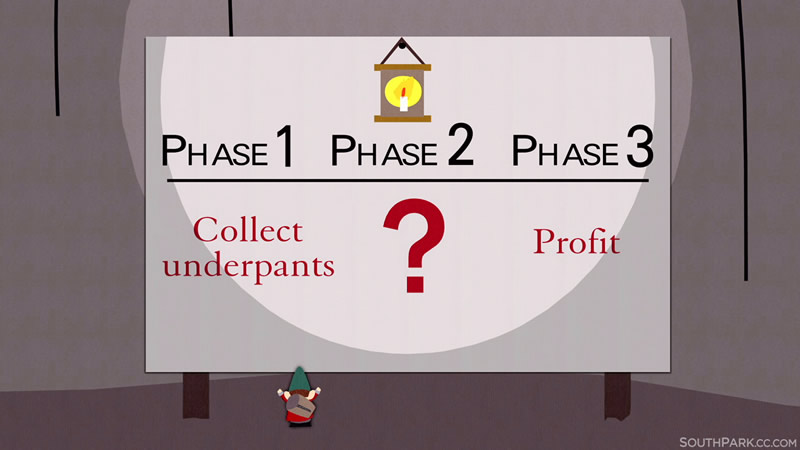 Although I’m not a South Park watcher, a colleague sent me this 35 second video and I immediately thought of the way some nonprofit boards function. Check it out and see how working at a nonprofit can feel a bit like dealing with the Underpants Gnomes.
Although I’m not a South Park watcher, a colleague sent me this 35 second video and I immediately thought of the way some nonprofit boards function. Check it out and see how working at a nonprofit can feel a bit like dealing with the Underpants Gnomes.
Hey… What’s “Phase 2?”
These enterprising little guys have a business plan that looks something like this:
- Phase 1: Collect underpants
- Phase 2: ?
- Phase 3: Profit
The gnomes have a goal: profit. They have a method: collect (steal) underpants. But they don’t have a clue how to turn Phase 1 into Phase 3.
Is your nonprofit operating the same way with “raising money” as the end goal, but no plan to get there? What’s phase 2 for your nonprofit?
Ideally, you want your approach to fundraising to look more like this model:
- Phase 1: Identify (Potential) Donors
- Phase 2: Build Relationships
- Phase 3: Ask for Support/Contributions
An Example of a Lack of “Phase 2”
A great example of a lack of phase 2 in action happened to me recently during my work with a great nonprofit board full of enthusiastic, engaged members.
One of them was particularly excited. He’d connected with a potential major donor and was eager to secure his first major gift. He was off to the races, without any type of plan.
This well-meaning board member convinced the rest of the board to hold a large event at a venue owned by the prospective donor — and wound up paying the supposed donor a huge sum of money without any real connection being forged!
If this organization had a solid phase 2 — that is, a set of guiding policies around donor cultivation — the results could have turned out differently. Things could also have gone well if their development staff had been able to keep them focused on building relationships. They were so focused on the money, that they were directionless and making poor decisions.
3 Tips for “Phase 2: Building Relationships”
With this in mind, here are three actions you can take to make sure your nonprofit board members don’t take the Underpants Gnomes’ approach to their donor cultivation efforts.
1. Guide your board members.
Guide board members, particularly new members, through their first donor cultivation meetings. You might even ask individual members to tag along during donor tours of your facilities or other interactions so they can get a solid idea of what to do. Create a plan for them and provide examples. This is important to do in group and individual settings with all of your board members.
2. Remind your board members that cultivation is a process.
As you know, major donor cultivation takes time — fundraising is about relationship building, and it doesn’t happen overnight. Understandably, your board members are eager and want to see results right now. This can lead to problems when a board member wants to “jump start” the solicitation (asking) process.
3. Have your board ask the donor open ended-questions.
You’ll want your board to ask open-ended questions, like:
- What type of philanthropic activities are you involved with?
- What is most compelling about our organization?
- What would you like to see changed at our organization?
This Week’s Task
Evaluate how well you’re doing in terms of guiding your nonprofit board members with “Phase 2” or donor cultivation. Does your board understand that cultivation can be a long process — and at the same time, are they keeping their eyes on the ultimate goal?
In other words, is your “Phase 2” understood and practiced by your board members, or is your board approaching fundraising like the Underpants Gnomes pursue profit?
As always, please share your thoughts and questions in the comments.
This post is part of my Year of the Fundraising Board series. Check out the entire series to learn how to create a stronger, smarter, and super motivated nonprofit board.

I love the comparison, Amy – and that video is hysterical, particularly the stunned realization that they have no plan for Phase 2. Sadly, of course, their determination to proceed anyway is far more common than we all hope. That said, it means our expertise is even more needed! Thanks for the post.
Amy–Perfect timing for this information for our education foundation–we’re launching a new fundraising campaign this fall and, yes, our fundraising committee is having “underpants–phase 2” moments already. This will make them laugh and also will help them understand why I oh-so-gently harp on developing and following an executable plan. Thank you.